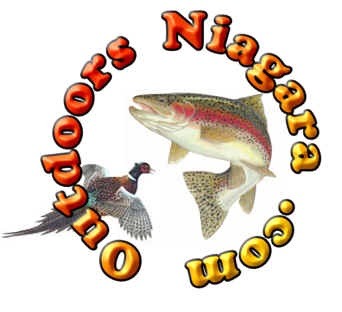 Outdoors Niagara exclusive
Outdoors Niagara exclusive Outdoors Niagara exclusive
Outdoors Niagara exclusive |
A
Great Niagara River Fishing Story
by Mark
Daul
PART 2
In part 1 we told you the
Lower Niagara River brags of the greatest steelhead fishing in the world. It
truly is the greatest, and the only way to find out is to try it. Then you can
tell us if we are right or wrong! There is a map of proven fishing areas in this
section of the river and at the bottom of this page there is a link to it.
Steelhead. Drift
fishing from boats is the most effective means of tying up with one of these
silver jumpers using egg sacks or egg imitations. Certain days lures are just as
effective and the banana baits such as Kwikfish or Flatfish in the variations of
the silver/pink, silver/green or silver/blue combinations and K-9 and K-11 sizes
taking the prizes.
The finest in World
class lake trout and brown trout fishing is said to be the best in the northeast
is right here. Fish these species in the same manner as steelhead.
Aluminum boats
16-20 feet are recommended with a trolling motor big enough for controlling the
speed of your drift and the direction of your boat.
Shoreline fishing
can be extremely effective and shore fishermen can score from the N.Y. Power
Authority’s fishing dock at the foot of the power plant or fishing the rugged
shoreline above or below that area.
Most popular shoreline fishing starts above the power plant starting at the Whirlpool State Park area and shifting down river to the Devil's Hole State Park area. There is rugged terrain to encounter on either one of these adventures so be sure you are in shape to climb rocks and stairs. Do not go off established trails and always travel light and with a companion. Don't forget your camera. You will encounter some of the most beautiful scenery in God's creation and you will want to show others where you ventured.
King Salmon - Coho
In March and generally into May, the fishing picks up at what is known as the
Niagara Bar. The Bar is located at the mouth of the Niagara River where the
river empties into Lake Ontario. At this time of year hoard's of lake trout,
brown trout and spring coho salmon and king salmon [chinook] all drawn by the
smelt and alewives that are the choice feed of these beautiful creatures. Again
16-20 ft. boats recommended.
Yellow Perch.
May and early June will find a lot of fishermen
searching out the fine tasting yellow perch. 11 to 14 inch perch considered lake
perch will be hitting on minnows on a 2-way perch rig or crappie rig. This
action will again pick up in late September and October.
June, July , August
and into early September brings the warmer water and the Bass and Walleye
fishing to the forefront. Most of the cold water fish like the salmonoids and
their forage base have moved from the river to the deeper, cooler waters of the
lake.
Bass.
There are a dozen smallmouth bass drifts favored by the
local fishermen and the best way for a new fisherman to find these spots is to
either ask at the boat launch or go where you see the fishing boats
congregating. You will learn real fast on how to latch onto one of these 2-3
pound fighting bronzebacks. It is not unusual to latch onto a 5 pound plus
fighter. Favorite artificial baits are numerous but the one standout is the
Berkley Power Grub. Live baits are leeches, nightcrawlers, crabs [crawfish],
minnows and big shiners and not necessarily in that order. Food fare for the day
depends on what other natural feed is available at the time. Again, the Bar at
the mouth of the river is a favorite location.
[TOP]
Walleye
fishing brings out the best of the hard fishing fisherman. Using the same live
baits as the bass fishermen and sometimes the same drifts, the walleye fisherman
will latch on some of the largest walleye in the entire northeast and including
Canada lakes. In the summer of 2000 walleye of over 14 pounds have been
reported. One taken by a reputable Charter Captain in the summer of 2001. 11 and
12 pound walleye are really happy catches and most all are released by concerned
anglers. 4 to 5 pound are common and anything just over 18" being fine
table fare. Size limit is 18" and that rule is strict and enforced not only
by the Conservation officials but other fishermen.
Nightcrawlers on
either a 3 hook worm harness with spinner and beads or a large silver/copper
spinner with a yellow sally [fly] tied on a 1/0 hook has been a local favorite
for over 60 years. Silver Kwikfish or Flatfish lures [banana baits] with the
front hook removed and a piece of nightecrawler fastened to the remaining hook has
proved to get ‘em on those tough days. K-8, K-9 sizes. All baits are tied with
a three-way swivel with a drop sinker mostly a pencil sinker so called because
of its shape. Weight will vary but start with 1 ounce as a rule of thumb and
adjust from there. Identical 3-way hookup for bass fishing.
The very latest method that is proving very popular is the "Drop Shot" method. There is an article with pictures explaining this method on this website.
Muskellunge
and Northern Pike are available but not abundant in the
Lower Niagara, meaning they are not a particularly targeted species. Most
fishermen spend their time targeting bass and walleye during the summer
months.........
CONTINUE TO PART 3 ![]()
Go Here to
find out about the now believed extinct, Blue Pike
a direct cousin of the Walleye Pike, A.K.A. Yellow Pike or Pickerel.